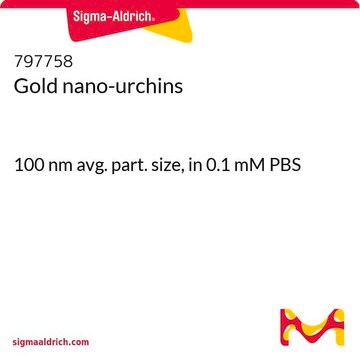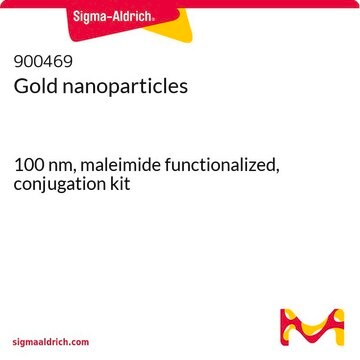These nanoparticles contained approximately 0.307 milligrams of gold per milliliter.
Kluczowe dokumenty
753688
Gold nanoparticles
100 nm diameter, OD 1, stabilized suspension in 0.1 mM PBS, reactant free
Synonim(y):
Au NP, Gold colloid
Wybierz wielkość
661,00 zł
Wybierz wielkość
About This Item
661,00 zł
Polecane produkty
Poziom jakości
Formularz
nanoparticles
suspension
stężenie
~3.8E+9 particles/mL
OD
1
średnica
100 nm
λmaks.
565-574 nm
temp. przechowywania
2-8°C
ciąg SMILES
[Au]
InChI
1S/Au
Klucz InChI
PCHJSUWPFVWCPO-UHFFFAOYSA-N
Szukasz podobnych produktów? Odwiedź Przewodnik dotyczący porównywania produktów
Powiązane kategorie
Opis ogólny
Zastosowanie
Informacje prawne
Kod klasy składowania
10 - Combustible liquids
Klasa zagrożenia wodnego (WGK)
nwg
Temperatura zapłonu (°F)
Not applicable
Temperatura zapłonu (°C)
Not applicable
Wybierz jedną z najnowszych wersji:
Masz już ten produkt?
Dokumenty związane z niedawno zakupionymi produktami zostały zamieszczone w Bibliotece dokumentów.
Klienci oglądali również te produkty
Produkty
Steven J. Oldenburg, Ph.D. provides an overview of lateral flow diagnostic assays and discusses the use of ultra-bright reporter particles based on the unique optical properties of gold nanoshells that significantly increase the sensitivity of lateral flow immunoassays.
Sustainable energy sources with high production efficiency are crucial for meeting increasing energy demand.
Gold (Au) nanoparticles have tunable optical and electronic properties and are used in a number of applications including photovoltaics, sensors, drug delivery & catalysis.
Nanocząstki złota (Au) mają przestrajalne właściwości optyczne i elektroniczne i są wykorzystywane w wielu zastosowaniach, w tym w fotowoltaice, czujnikach, dostarczaniu leków i katalizie.
-
How many grams of gold are contained in these nanoparticles?
1 answer-
Helpful?
-
-
本製品の吸収スペクトルはどのようなものでしょうか。 可視域と赤外域が知りたいです。
1 answer-
This item is a product of Cytodiagnostics, Inc. Please see the supplier information below regarding the absorption properties of the Gold Nanoparticles. Note that the dark blue in the graphic indicates the 100 nm, 753688.
Helpful?
-
-
How do you attach gold nanoparticles to oligos?
1 answer-
To attach gold nanoparticles to oligos please view the information in the attached reference - Bioconjug Chem. 2011 Apr 20;22(4):794-807. Epub 2011 Mar 28.
Helpful?
-
-
Can the Gold nanoparticles be frozen?
1 answer-
No, the Gold nanoparticles should not be frozen. If frozen, the gold nanoparticles will irreversibly aggregate, turning the solution clear.
Helpful?
-
-
How do you attach gold nanoparticles to peptides and peptide conjugates?
1 answer-
To view information on how to attach gold nanoparticles to peptides and peptide conjugates, please view the information in the reference - Rosenthal, S. J. and Wright, D. W. (Eds.). (2005), p. 91-92. NanoBiotechnology Protocols. New Jersey. Humana Press.
Helpful?
-
-
How do you attach gold nanoparticles to glass?
1 answer-
To view the procedure on how to attach gold nanoparticles to glass please view information in the reference - Journal of Atomic, Molecular, and Optical PhysicsVolume 2012 (2012). Article ID 683830, 6 pagesdoi:10.1155/2012/683830
Helpful?
-
-
How does the storage temperature relate to shipping conditions?
1 answer-
The storage conditions that a Sigma-Aldrich catalog and label recommend for products are deliberately conservative. For many products, long-term storage at low temperatures will increase the time during which they are expected to remain in specification and therefore are labeled accordingly. Where short-term storage, shipping time frame, or exposure to conditions other than those recommended for long-term storage will not affect product quality, Sigma-Aldrich will ship at ambient temperature. The products sensitive to short-term exposure to conditions other than their recommended long-term storage are shipped on wet or dry ice. Ambient temperature shipping helps to control shipping costs for our customers. At any time, our customers can request wet- or dry-ice shipment, but the special handling is at customer expense if our product history indicates that the product is stable for regular shipment.
Helpful?
-
-
My gold nanoparticles settle out of solution upon storage. Is this normal?
1 answer-
Settling of gold nanoparticles on the bottom of the storage flask is completely normal and is especially common for larger sized particles, which settles at greater speed. Settling does not affect the performance of the particles. Prior to use, simply swirl the solution to properly disperse your gold nanoparticles and obtain a homogenous solution.
Helpful?
-
-
Do I need to wash my gold nanoparticles?
1 answer-
For most applications, our gold nanoparticles can be used without any additional washing steps. If you have a sensitive application that requires additional washing the best way to do so is by either centrifugation or filtration.
Helpful?
-
-
Which gold nanoparticle size should I choose for my application?
1 answer-
The size of gold nanoparticle to use is very depandent upon the intended application. Generally, smaller particles offer better sensitivity in applications such as immunogold labeling due to less steric hindrance and the ability to bind more gold nanoparticles to the desired target. Small gold nanoparticles are less visible than larger particles, however, which must also be taken into account.As an application example, particles with a size between 30-50nm are particularly useful for the development of rapid tests such as lateral flow assays.
Helpful?
-
Active Filters
Nasz zespół naukowców ma doświadczenie we wszystkich obszarach badań, w tym w naukach przyrodniczych, materiałoznawstwie, syntezie chemicznej, chromatografii, analityce i wielu innych dziedzinach.
Skontaktuj się z zespołem ds. pomocy technicznej




